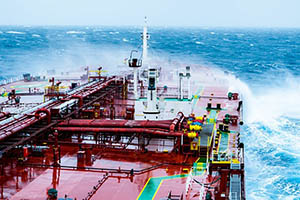Disruptions to international maritime trade
 The sector's current growth is mainly accounted for by increased demand for containerized freight. Other types of cargo, such as gas and dry bulk, have also grown, while crude oil trade has declined.
The sector's current growth is mainly accounted for by increased demand for containerized freight. Other types of cargo, such as gas and dry bulk, have also grown, while crude oil trade has declined.
The early 2020s had been marked by the global health crisis and the Ukraine-Russia war, the combined effects of which are weighing on global maritime trade. Supply chains are particularly affected by these two events: ports closed or congested, new routes opened, etc.
The disruptive factors of international maritime trade
Unstable political and economic environment
In 2022, the global political and economic environment remained unstable and complex, with inflation and the cost of living on the rise.
Health policies in China, the world's leading exporting country, had also disrupted shipping. China's sanitary restrictions resulted in factory closures, disrupting manufacturing activity as well as logistics and supply chains.
In Ukraine, a major exporter of grain and foodstuffs, the Black Sea ports were temporarily closed following the outbreak of war.
Read also | The invasion of Ukraine, an exceptional risk
In addition, a number of major ports, notably those in South Africa, Germany, South Korea and the UK, were affected by strikes and industrial action, which had a negative impact on shipping.
Natural disasters
In addition to disruptions of a health or social-economic nature, world trade has also been disrupted by a number of natural disasters in recent years, including flooding (river shipping), hurricanes and heat waves, particularly in Australia, Brazil, Pakistan, East Africa and the USA.
2006-2022 trends in international marine trade
According to a 2022 UNCTAD study, seaborne trade is expected to grow at a moderate average annual rate of 2.1% over the 2023-2027 period. This growth amounts to 3.3% over the last three decades.
After years of euphoria, performing a locomotive role, containerized goods trade grew by 1.5% only in 2022. This mode of transport is poised to regain some momentum in 2023, with an expected growth of 1.9%.
Trends in international marine trade and in GDP
This slowdown in marine traffic is not only the consequence of the lockdown measures pertaining to the Covid-19 pandemic, but also of the highly unfavorable macroeconomic situation. The slowdown in China's economy alone is causing major economic disruption around the world.
As a result, the share of goods in consumer spending is falling. Consumers are spending less as inflation and the cost-of-living rise.
The UNCTAD report highlights the impact of the Ukraine-Russia war, which is changing the configuration of trade flows and disrupting supply chains. Buyers are looking for alternative suppliers who are generally further away, so the number of ton-miles is increasing.
Although impacted by the war, container shipping has become essential to the international exchange of goods. Almost one-sixth of the world's seaborne freight is carried by these specialized vessels, fitted out to facilitate the loading and unloading of goods.
The world container ship fleet, which stood at 3 500 units in 2006, reached 5606 vessels by the end of March 2022. Today's container ships not only outnumber their predecessors, but also have a much greater port capacity than in the past.
